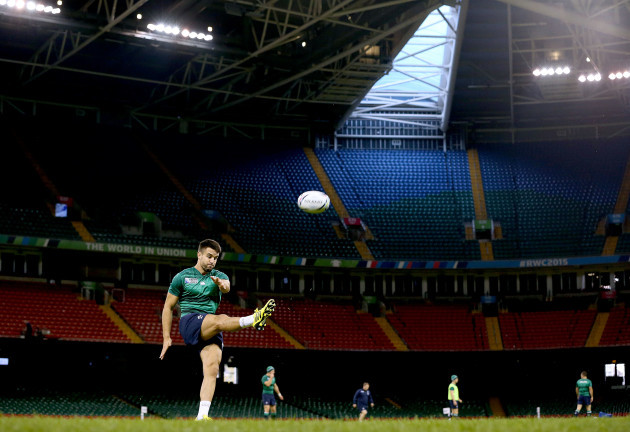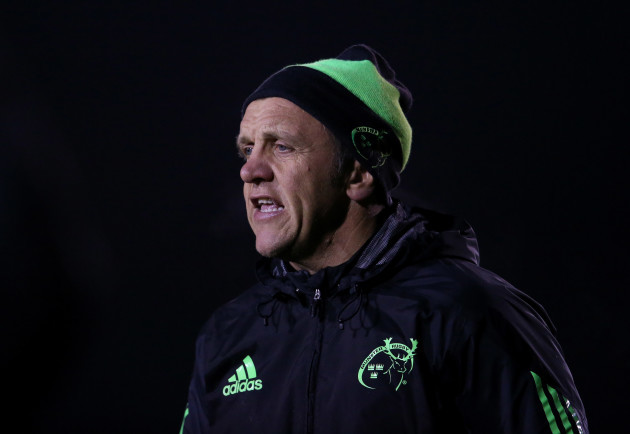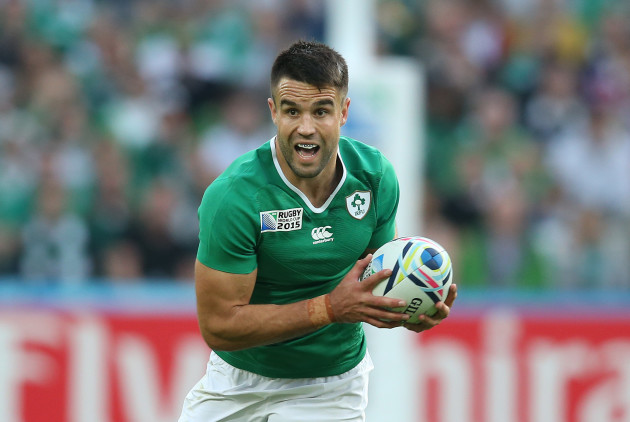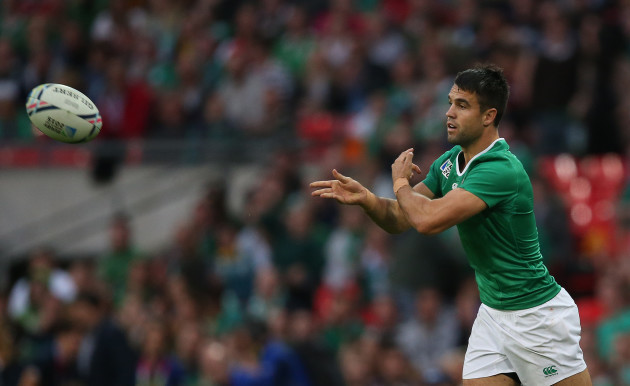Murray Kinsella reports from Cardiff
“IT SOUNDS WEIRD, but I love the look of a class spiral pass in the air.”
Conor Murray is among the lucky few of us who take an aesthetic pleasure from their job. As scrum-half for Ireland, as well as with Munster, the Limerick man gets the opportunity to fire off a fair few passes.
There were 93 against Italy last weekend, although Murray will often surpass the 100 mark if Ireland’s game plan allows him to do so.
The 26-year-old is a devotee of technically superb and accurate passes. It’s the biggest part of any scrum-half’s duties and Murray feels he has developed a greater appreciation for which type of pass to choose in which circumstances.
It’s not always about stinging the hands of his teammates.
“I always loved passing, putting as much spin on it as I could,” says Murray, “you have to be passionate about what you do. As you play more rugby, you understand what kind of pass is needed.
“I probably always used to rocket the ball to try and make the pass look as good as possible. But you need sympathetic passes around the side of the ruck or if you’re coming back against the grain, not leathering it at a fella.
Murray is playing in his second World Cup, has an impressive Lions tour on his CV and has also won 40 Ireland caps. He is one of the best scrum-halves in the game, but insists that he has many areas that still have huge growth potential.
Greig Oliver is an influential man in Murray’s efforts to get even better. A former Scotland scrum-half, Oliver played at the 1987 and 1991 World Cups and is now highly-regarded as a technical coach.
The Scot is an elite player development officer with Munster and also serves as Murray’s scrum-half coach, working with the Ireland international once or twice a week on the core skills required for the position.
“When I first started in the academy, I began working with Greig,” says Murray, who also played under Oliver at Garryowen. “I’m in my sixth year working with him now and he’s a fella I would have practiced so many things with.
“I’m still working with him and he keeps me on my toes and keeps things fresh. It’s a good fitness hit working with Greig as well.”
One of the things the pair have focused on is Murray’s pacing from ruck to ruck. Arriving to move the ball away isn’t always about simply sprinting flat out between rucks. Murray has learned that sometimes easing off slightly makes everyone’s lives easier.
“I used to arrive at rucks – not on the touchline but in and around midfield – I used to them too quickly, almost at the same time as our cleaners. I used to end up having to hit rucks or I’d get hit by our cleaners and it would slow things down.
“I’ve had to think about that as I’ve progressed in terms of timing my arrival to the ruck. I have to look at our ball carrier and if he’s making ground or going to deck, rolling well and I know he’s going to get the ball back clean, I can get in just behind our cleaners and try to time my run.
With the wide rucks, you’ve just got to go hell for leather to try and get there on time before the ball gets kicked out.”
Getting to virtually every single attacking ruck means Murray tends to rack up fairly notable GPS scores, with the scrum-half saying that he generally covers a similar distance to the back three players, depending on the game.
He points to recent a 56-minute training session in which he covered close to 5 kilometres. Add another couple of kilometres to that on game day, again depending on the fixture.
The point here is that Murray has had to work hard at building the sort of fitness that means he always possesses an ability to burst when it’s necessary to get to a ruck or support a linebreak.
“It’s important for a nine, not to pace themselves, but to know that if we make a linebreak you’re fit enough to make the supporting run on the inside,” says Murray.
“During a long phase of play, you’re so fatigued and it’s hard to make that run so you’ve got to be thinking ahead. When I get tired I have a tendency to pass and then follow my pass, rather than go upfield.”
Going upfield is a habit that Murray has worked particularly hard on in those sessions with Oliver. New Zealand scrum-half Aaron Smith is the master of the pre-emptive line, moving forward up the pitch after his pass in anticipation of linebreaks.
Of course, a linebreak doesn’t always come further out the line, so scrum-halves like Murray must make strong decisions around when to get ahead of the ball on this type of line.
“I know I’ll spend the rest of my career trying to balance it!” says Murray with a smile. “It doesn’t always work. I did it in training the other day, I went upfield on the inside when I thought we were going to go to the width and break.
It looked like the breakdown was going to be upfield but it ended up being 15 metres behind me. I had to go all the way back and that ball was slow.
“I think in that area of the pitch, we were in our half, it’s not crucial that that ball is really quick. Sometimes it’s just a balance, sometimes you get it right and sometimes you don’t.
“Sometimes when you don’t do that upfield support line, we make a break and you picture where you could have been. You could have been under the sticks! It’s a thing you’ve got to keep trying.
“You’ll do 99 of them and on just one of them you’ll get the pass on the inside and get a try. That’s where it pays off. It’s another thing Greig got me to do. I remember looking at Jimmy Cowan and he used to pick up so many tries that way.”
Former New Zealand scrum-half Cowan is not a player we would have immediately picked out as having been influential on Murray, but he’s a fan.
In makes sense on reflection. Cowan won 51 caps for the Kiwis between 2004 and 2011, when Murray was learning what it really meant to be a scrum-half. They even trained against each other in 2008, when New Zealand ran against a Munster academy team in Limerick.
Cowan was the king of the inside support line, according to Murray, and he hopes to continue his own improvement in that department. There have been more frequent glimpses from Murray, now he just needs his teammates to bust the defence regularly.
Another key role for Murray is one of communication. It’s perhaps not frequently highlighted as the most important ability for a nine to possess, but clear and accurate chat is vital, both with teammates and the referee.
As a player who is almost always around the ruck in attack and defence, Murray is usually in position to attempt to influence the match official’s decision making.
You have to find a balance in between annoying the ref and being correct,” says Murray of speaking to referees during games. “I think you’ve got to keep studying the game and being aware of the rules, especially at nine.
“For example, if the opposition try to hold someone up for a maul but as soon as the carrier’s knee hits the ground, that’s a ruck. The defenders have got to release, so things like that that I can see, you’ve got to be on top of that.
“Joe (Schmidt) and Mervyn Murphy and Vinny Hammond (Ireland’s analysts), they’re very good at making you aware of new rules changes and things to have in your head, just to be clear and make sure you have things in your head.
“They can be big decisions in the game and you’ve got to know your ref, know who likes to be talked to or not talked to.”
Murray’s communication can often be the difference between Ireland wasting bodies in defensive rucks and filling the line more ideally, sometimes even preventing breaks further out from the ruck.
“You’re more often than not behind the ruck and it might be ok for our tackler plus one to go in on the ball, but if you see that it’s probably going to be quick ball for the opposition and lads are trying to honeypot around the ruck, you’ve got to let them know,” says Murray.
“That’s a basic thing for me to do, scan and then tell lads that it’s a dead ruck.”
Murray is not merely a defensive communicator, however. His defensive power is a real strength in the Patrickswell man’s armoury. He looks to get into the line and contribute whenever possible, but also understands the importance of sweeping.
I like coming into the line when I’m needed,” says Murray. “You have a very important role behind the line in covering chips and grubbers. Sometimes you want to get into the game by making a tackle with a bit of a collision and you don’t want the frontline broken.”
When it does get broken, Murray is often lying in wait.
“You’ve got to read and make sure your footwork is right to take that man down,” says Murray of those one-on-one tackles in open field. “Usually, if it’s further out it’s wings or wide players coming through and they obviously have good footwork. It’s nice to make those tackles but we don’t want too many linebreaks.”
Ireland will take comfort from knowing Murray is lying in wait for any Frenchman who does bust the line today.





